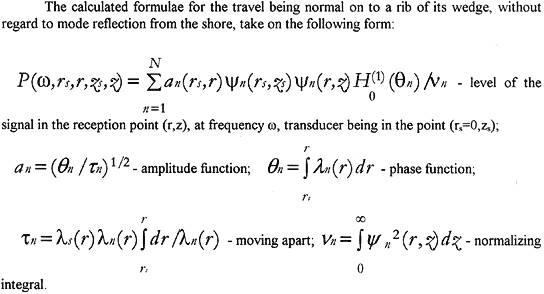introduced by waveguide as a transmission channel by quantitative criterion, the impulse characteristic being calculated or measured. To do this, it is essential that an emitted signal, which characteristics (frequency band, duration, structure) be in agreement with conditions of propagation along the travel, capabilities of transmitting and receiving/processing systems, should be selected.
The use of complex phase-manipulated (pseudorandom) signals enables us to obtain a measureability of waveguide impulse characteristic in the hydroacoustic experiment by recording the signal transmitted (reference) and received at the input end of the waveguide, and by computation their cross-correlation function. Such kind of signals when amplitude and frequency instability of acoustic source being occurred have the structural stabillty predetermined by the law of phase variatlon of the symbols that are components of signal. It is the processing that provides the basis for correlative properties of complex phase-manipulated signals and their pseudorandom character.
2. The theory of measurements
The network of determining waveguide impulse characteristic during the experiment by using phase-manipulated signals in form of M-code was implemented on the Posiet Bay stationary travel which acoustical properties approximating the .system "homogeneous liquid layer of variable depth-homogeneous liquid half-space" (adiabatic approximation) [3]. Determined in the calculations were the averaged group delay time of individual normal waves within the frequency band of 225-275 Hz for the waveguide having the sound velocity of 1500m/sec in the layer, 1800m/sec in the ground, the proportion of the half-space and the layer density of 2.06 and the depth 38m, that an average comply with the real travel parameters.
Geometry of numerical experiment was specified by a distance of r=19125m and putting the receiver deeper z=42.6m (a depth of setting is 43.1m), putting the transducer deeper zs=28.0m (a depth of fixing is 28.7m), tangent of inclination angle changing along the travel of signal propagation and not exceeding 0.001 (at the place of fixing receiving systems).
